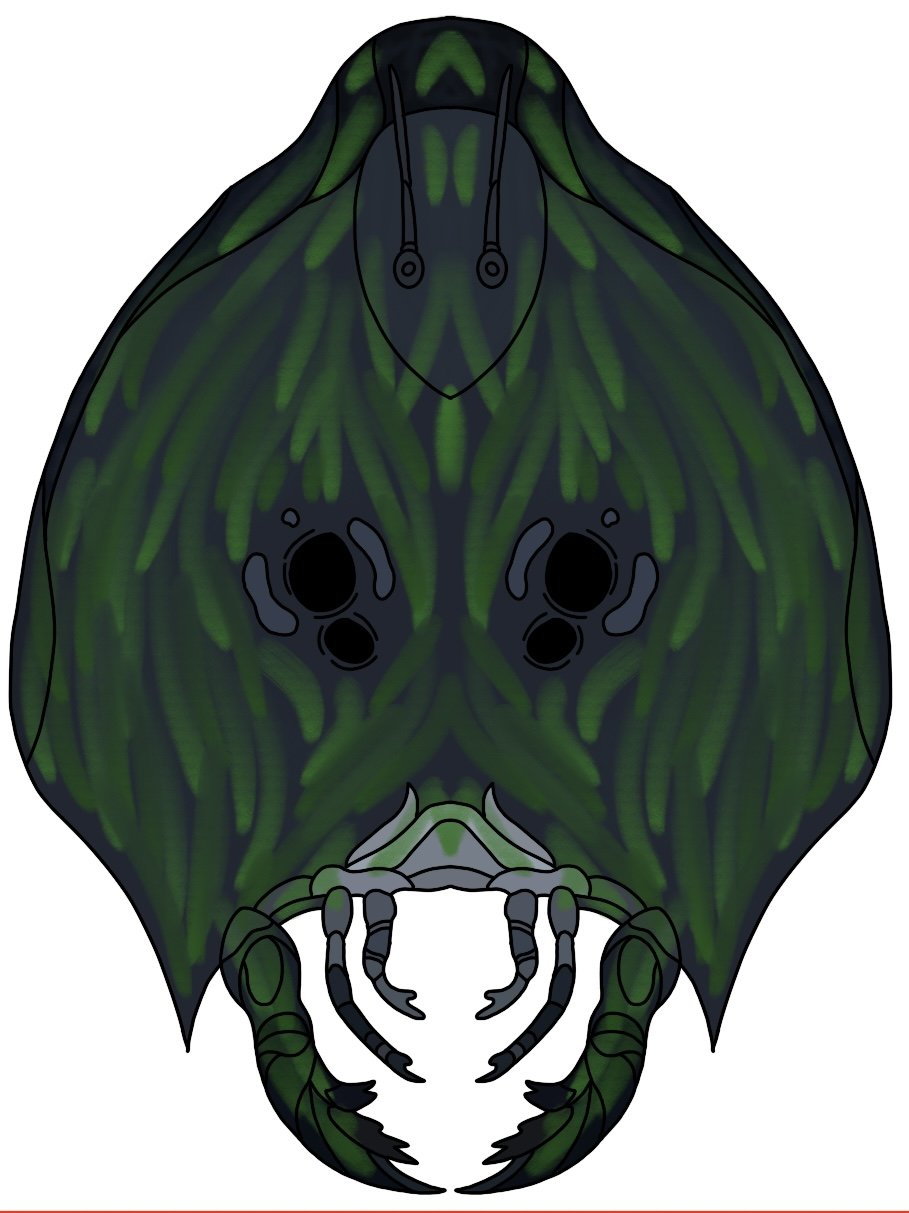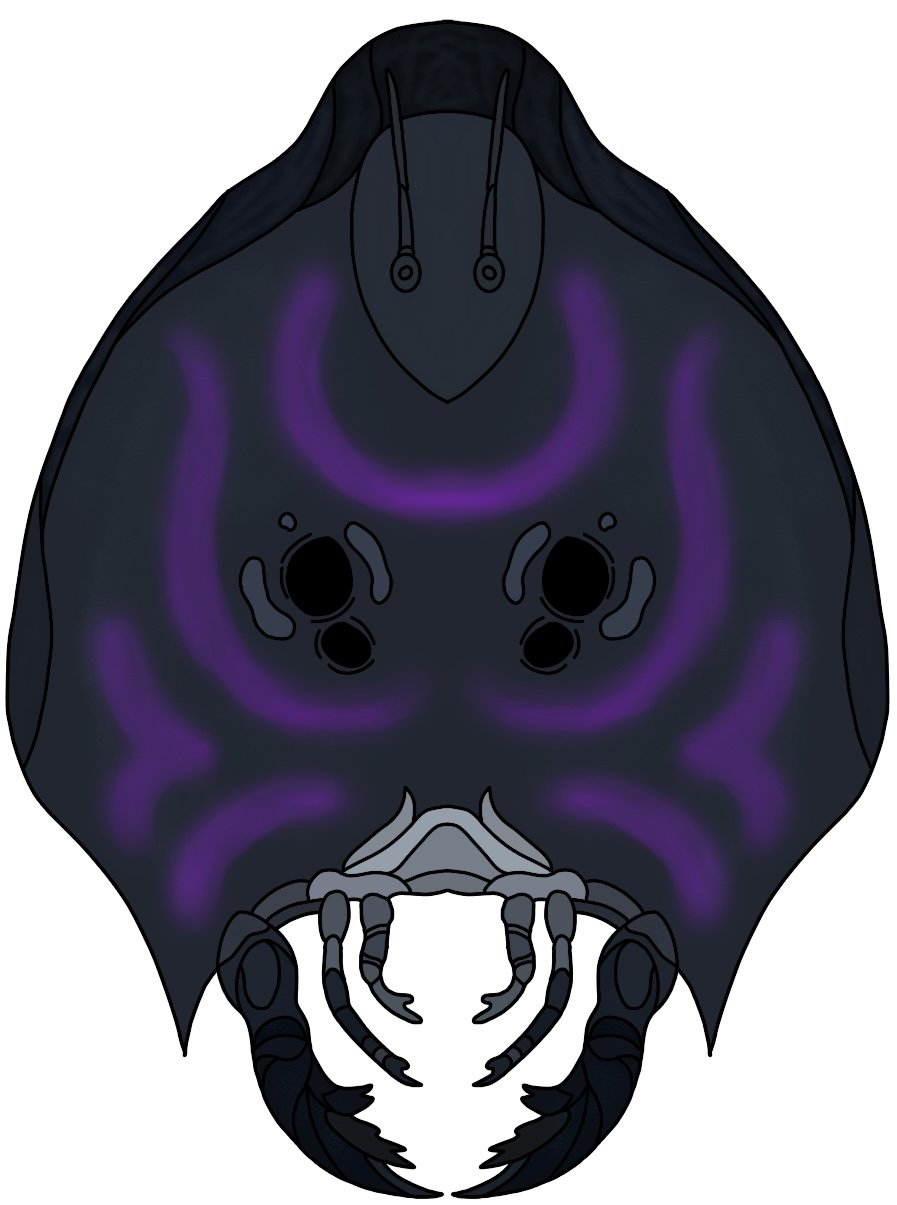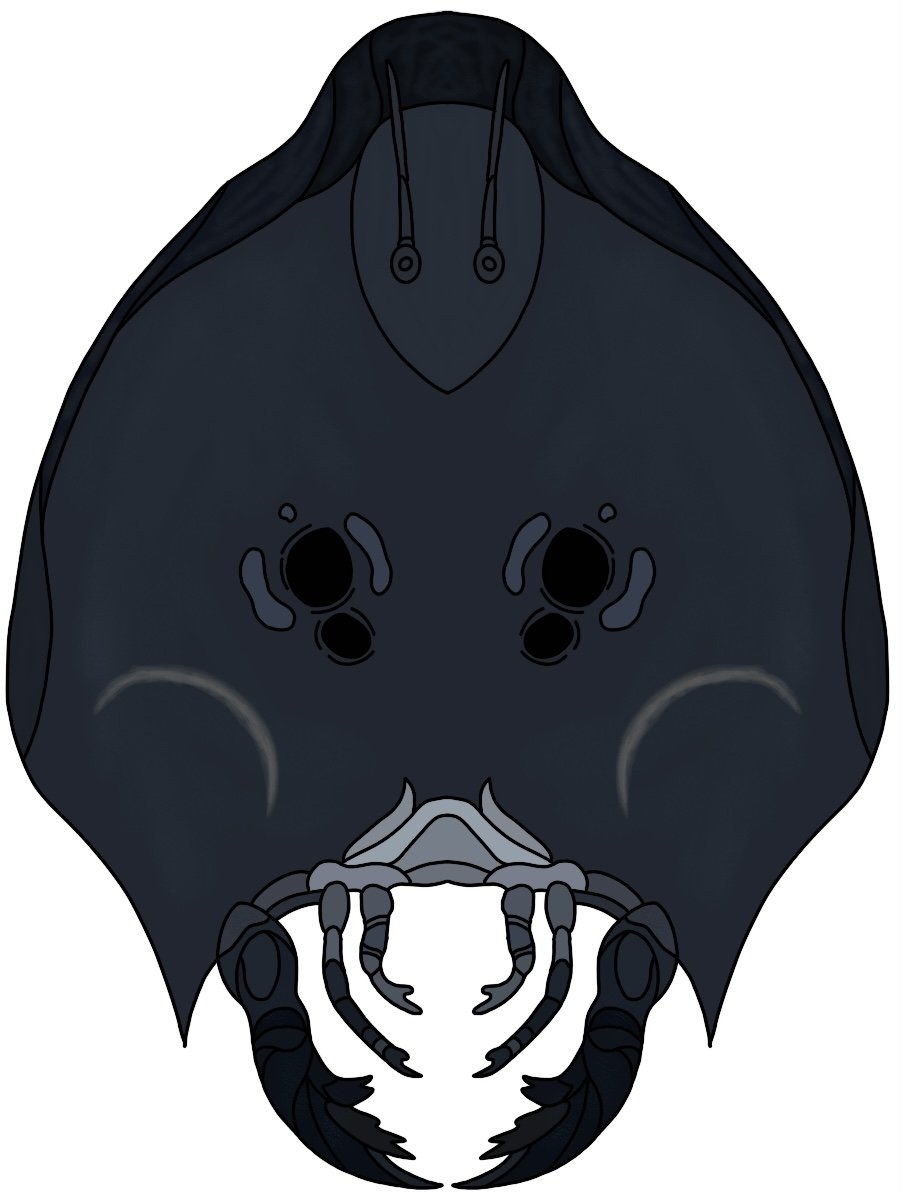
The slivers, Dal sirafatas
Intro
Slivers are a species of Alien that are native to the planet Parasirafat. They are most notable for their large size, standing at 6 to 7 feet tall and being 20+ feet long at times. They are also known for their modular limbs; through a complex internal and external systems they are able to grow new limbs relatively quickly and add to their bodies. The so called “base” of a sliver is simply their head and the first main section that acts as a stomach and holds other bodily organs.

The planet of Parasirafat
This planet orbits a binary star system, its two stars of Solama’inor and Solamindor are easly seen in the night and day sky but are dimmer than our sun, see the solar system for Parasirafat to see more exact information on its cosmological scale and information. Of the planet of Parasirafat its self, it enjoys a general warm temperature for humans, ranging from 10 to 35 degrees Celsius. ( 50 to 97 F). The air is breathable but uncomfortable and over the whole lifetime can lead to some health problems for humans.
Albedo, .25
Greenhouse effect 5
Atmospheric pressure of 1.3
O2 content 35%
Carbon dioxide is 4% ( this is considered very dangerous by OSHA, but it is not deadly right away) ( this is about 30,000 parts per million equivalent )
Aragon .5
Nitrogen 60.5%
All of this combined means that the planet experiences on average a surface temperature of 27C.
This excess of carbon dioxide, thicker atmosphere leads to plants being a more pale green than on earth, as well Fungi is more present. The carbon cycle is quite complex and developed as well as the nitrogen cycle. This also means that vast forests cover the earth with a large desert in the north of the planet.
Other items of note on the planet is its smaller oceans are all salt water, less salty than earth but still notable. Organism on the planet have either adapted strategies to filter out this small amount of salt or find sources of potable water. This planet has a higher concentration of surface metals and so much of the flora and fauna uses this it’s in biology
Sliver biology
Slivers are carbon based lifeforms that needs to consume other carbon based lifeforms to gain energy, the process is quite similar to on earth with the breakdown of food into ATP which is used to power cells. The main feature of slivers is the modular structure.
The modular structure is a ball and joint system where in slivers grow a new limb from a special area on their main segment on their back, when its fully grown it will be usable. When a sliver makes a connection with a new limb, initial muscle will quickly be realized from an existing limb into the new one, neural fibers will also connect and within about 10 minutes the limb will be functional. it should be noted that for a connection to be fully secure this takes a new days to a week for everything to grow and be at full strength.
Slivers weight is highly dependent on limbs and segments. The main segment is around 450 pounds, and each main limb is around 20 pounds. Smaller limbs are in the 5 to 10 range. The head of a sliver is around 30 pounds. This means that one sliver could easily be over 1000 pounds.
Sliver limbs
A sliver limb is quite complicated, but all limbs follow the same basic structure of an inner support like a bone that works to hold neural fibers and an anchor for muscle fibers to attack to. An outer shell that is made of a chitin like substance and inner space that is often filled with a simple form of fat or flesh to act as an insulation and protection. Sliver limbs do not contain any organs ( with the special exception of those designed to such as main segments ). The limb’s muscles are all given energy produced organs by the main segment and oxygen is transmitted to their hearts in the main segment as well. This means that if a Sliver limb is damaged or removed it is not threatening to the slivers main body.
For a sliver to remove a limb they must make a conscious effort to separate the muscles connecting the limb form those it wishes to keep, this often takes around an hour but can be done faster with the risk of injury.
Sliver Sensory experiences
Slivers have many sensory perceptions. The most important for them is vision. They have 4 eyes, a pair of main eyes and a pair of smaller eyes. The main eyes have red, green, and blue cones and rods and are used most often. The second smaller eyes have rods as well as red and ultraviolet cones. They can see a total range of 450-1300 nano meters of light. The second eyes also are better at seeing faster and sudden movements, these mean that the second eyes are used much more in hunting.
The also have a pair on small antenna, this contains their main method of hearing, and but it also detects some chemicals in the air like smell.
Slivers have small fluid filled sacks near the sides of their heads as well as the front of their face near the mouth, these are what detect mild electromagnetic forces. This has a small amount of use in detecting objects in the environment but is not the most used sense.
The sense of taste and smell is both done within the mouth, taste is directly in the inner mouth and smell is the outer area near the many mandibles. Often they will move the mandibles to push air towards there olfactory receptors.
The vestibular and kinesthetic sense is all within the brain, small sacks of fluid in the brain control the vestibular sense and a larger lobe is responsible for the
Sliver connection
Connection is when two ( or more ) slivers physically connect their bodies, this can either be with normal libs and when this happens just the neural fibers will connect or it can be with a special designed lib end for connection, often this in the smaller pair of central limb slots on the main segment. The second method is much preferred as it is faster and more clear in its information transition. When this occurs visual and emotional information will sent over and interpreted, its as if the sliver is experiences a memory of the other. This memory is almost all visual but does include some parts of sounds, hearing, smell, electromagnetism, and taste. it does not bring kinetic senses or vestibular senses.
Sliver mating
Sliver mating is a long, unique, and strange process. Mating occurs when a pair of slivers is connected many ways cross limb and stays this way for a Signiant period of time, often a few weeks. When this passes, and if both parties are willing, they will start to grow a main segment between the two of them, this will also include a head and so start to grow alive. This usually takes around 11 months ( earth time ) in total. At the end of this process a new third sliver will be alive, often the third sliver will start to gain consciousness around 1 month before its ready and within the month it will grow into a capable new sliver, it inherits some memories and personality of its parents, this Is like mixing DNA but with the mind.
Slivers are serial monogamous, meaning they have one partner at a time but may have many in their lifetimes. Slivers will often raise their children, but this is a period of teaching as newly separated slivers are fully capable of living themselves, this period may be around 1 year but can be much shorter or longer.
Sliver Brain
The brain of a sliver takes after many ways of a complex and sentient brain, it possess a large frontal lobe and deep brain density. This is firstly in a slightly different shape with the head being a different shape. They have a highly developed and dense motor cortex, their visual cortex is also much bigger and has an additional lobe for processing infrared light from the second pair of eyes. They have a much different system for sexual drive and this is focused in the “grey lobe” this area also works as interpretation when slivers communicate via direct connection. They have a small are dedicated for direct language processing as well as smaller lobes for auditory information and this is less relevant to their environment and lifestyle. They have an equivaled amount of pattern recognition as humans.

Sliver Gender ideas
Slivers do not have biological sex, because any two slivers can mate and have a child if they are willing there is less importance of what gender means. They do have societal divisions that humans would often place as gender, as well when they mate around 90% of the time it is with a sliver of the other gender. Gender can also change for a sliver, with about 20% changing in their lifetime, this is not seen as a social taboo and is a normal part of life and society.
For a sliver to be male a better idea to think of here is “active” this is they do active activities and create, they will hunt and build, make tools and art etc. These slivers have more drive to go out and create.
For a sliver to be female a better idea is to think of this as “passive” they work to maintain things, they will cook, fix buildings, maintain crops and harvest etc. These slivers continue cycles and stuff already set In motion, but they will sometimes put their own spin on it.
Gender plays a less key role in society, as activities can be done by any sliver just some are better at others. The biggest effect is that when mating if a male and female sliver mate is creates a balanced child, one who has features of both parents and thusly can decide its gender.
Sliver life and death
Slivers are long lived beings; some speculate that they have a natural life span but its hard to tell at the current moment. They are quite durable and due to the modular system of limbs they are quite hard to kill. This brings up an average life span of around 250 years. Some of the oldest slivers are around 800 years old.
At the beginning of life, from separation from their parents to the first 5ish years of life is a stage of heavy learning stage where they have little direct responsibilities and do a large amount of discovery, this is like adolescence in humans
From the ages of 5 to around 25 they will start to settle into a role, this means finding a gender and job as well as potentially a tribe.
After 25 they will go through cycles of mating with another sliver if they so choose around every 20 to 35 years and this will happen around 2 or three times in their life.
After this their libido simmers and they continue to be a member of society, working and living.
The main ways that slivers die are sickness, main segment failure or accidents. If parts of the main segment break or stop working than it can’t be repaired much and so will cause eventual death. Sickness also can cause problems within the brain or with limb connection and this can cause death. Lastly is simple injury, if their brain is damaged it often fatal as well as important internal organ such as their heart, stomach, and lungs.
Sliver technology
This is technology before the landing of humans. But make note that little changed with the introduction of humans due to deliberate decisions from the governments of various nations to mostly leave the slivers to their own.
Slivers mostly live in small villages of a few dozen members; they farm and forage food as well as hunt. They lack real weapons as they will simply have differently made limbs to fill that purpose.
They do have fire, and its quite easy to start fires from the higher percentage of oxygen in the atmosphere. This also means that fire can get much hotter. This combined with high percentages of surface metals in the ground at flora and fauna means that they are a quite developed metal craft. This is used to make tools such as materials for building, watering storage, containers but it mostly used for decorative purposes such as jewelry or art.
While villages are the most common, some larger cities exist with many thousands of members, when this happens more complex systems such as sewage and transportation networks must be made, carts and larger transport exists to carry large amounts of goods.
Sliver culture
Slivers are largely concerned about roles within the village and city, many slivers are known for what they do. Bonds also form between those from different places but with the same role, two hunters from different villages might connect with each other to share ideas. Slivers also can have hobbies, stuff that may not be their role but that they do for fun. Culture is hard to grasp because its so fundamentally different and alien.
Sliver Religion
The slivers have a few main religions, and each varies in their dedication to their beliefs, some are very active and others have no belief at all. Often larger cities are more religious than smaller villages but this is a trend not a rule.
The church of the one, this is the belief that all slivers are merely shards of one greater being, they seek to have all slivers merge peacefully into one being and then that single being will become god. The way they practice this is by long periods of time spent connected to one or more slivers for non mating purposes, they believe that the more they are connected the closer they are to god, this is enforced by an effected call memory bleed where after a long period, often many years of connection the two slivers minds will start to blend into a single consciousness.
The church of experience, they believe that only through experience and different activities they can gain spiritual fulfillment. This often involves novel experiences and large amounts of travel making them nomadic people.
The church of the eldest. This is a group that follows the oldest slivers alive, they work for them and belief that there is great wisdom with a long life, they them selves seek a long life as well.
The church of golden light, these slivers believe that the following of the king, a single sliver mind that is reborn over and over again is important. This king in notated for having a golden colored head, this is a very rare mutation and so its thought that this sliver has and will live many lives, gaining spiritual fulfillment and that their followers can glean a part of this enlightenment.
The church of exclusion, this group is not a religion that is spread but more one that is self discovered by each sliver that follows it. They believe in self-sufficiency and no connection to other slivers, they are also discouraged from living with others but this is up the decisions of each sliver that follows it. These beliefs do vary and this church is more a grouping of a. set of ideas rather than a strict code.
The church of the 6, this is a group that has long sense worshiped the idea of the number 6 and the hexagon and believed it to be sacred, when humans showed the slivers the carbon atom and its naturally hexagonal structure this religion flourished as its believes have been proven.
Sliver language
The sliver language is a complex set of multi layered communication. In general most slivers prefer connection for sending ideas to each other, but other methods exists.
The most basic of these is limb gesturing, this is stuff like pointing and moving the libs to convey the most basic of information, this is done when hunting or when a very basic idea needs to be communicated fast, its also non standard and so it can vary from different regions.
The second form of communication is a loose set of drawings and symbols that carry meaning, these are often left as static marks or directions for others. around 8 to 10 of these symbols exist and they are standard across the planet, this is due to a long ago shared genetic memories and common exchange.
The third form of communication is a set of a few thousand symbols, much more complicated than the second set this is used for writing longer and formal things or names. It is variable on what symbols means what and so its only used in cities most often and will sometimes require an interrupter to read it property. These function like Chinese logograms in their meaning, there does exist a simple grammar but it is loose and not always followed. This set can carry much more information but does require much more prior knowledge.
These are the main systems that slivers use to communicate with each other before the arrival of humans, they would continue to be used after humans but some change does occur.
Sliver agriculture
Slivers have been capable of agriculture as well as animal husbandry, using tools and complex calendars to track season cycles. They also practice mixed land usage, crop rotation, and complex food making. While a large part of the food from Slivers comes from hunting, many times these lands where hunting occurs are not completely wild, it will be a controlled area where the amount of animals hunted are tracked as cause over hunting and maintain population stability. This also means that in the hunting areas certain animals are not hunted at certain times of the year, often corresponding with mating cycles of said animals.
Slivers semi-wilds are areas where food crops are grown in mixed usage with domesticated animal as well as natural growths like trees and foliage, often smaller crops and animal feed will be grown here, but plants like fungi and small root vegetables are grown here.
Slivers in general follow a 4 cycle practice for farming, 3 years of crops and 1 year to let the field lay fallow. The three main crops are a simple grain, which grows about 3ft tall and can be used for bread and beer making. A ground tuber, much like the earth potato but larger being around the size of a cantaloupe. Last is a type of orange bean that is commonly eaten. Many other crops exist but these are the most common
Sliver eating habits
Slivers need to eat in accordance to their number of limbs and segments. They mostly have a meet based diet but they are full omnivores and eat ample plants as well. A sliver will need to consume around 10,000 calories a day for the main segment, around 5,000 per day for additional segments and around 100 per day per limb. They also need on average around 5 gallons of water per day. They will eat on average 3 meals a day with 2 main meals, a large morning meal often made of vegetables and preserved foods but with a small amount of freshly prepared food. A mid day meal that will be smaller and informal and an evening meal that will be mostly fresh food and the hunt for the day.
Slivers do have the capability to drink beer and other alcohols, but do to differing brain chemistry the alcohol only provides a sleep causing effect instead of the many that it can cause in humans. For this reason beer when it is drunk is done so in the late evening before sleeping.
Sliver names
Slivers have a complex naming structure, instead of being given a name by the parents as in humans, and one that is rather arbitrary or with familial components. Sliver names are self made, and have potential to change. Due to their language a name is often a notion or simple assortation of the image of a sliver, many slivers in this way are given names by other that reflect their personality or occupation. Many other slivers may choose a name by making a distinct feature on themselves, paints and making on the body, a unique limb, and jewelry are the most common ways of doing this. Some many even choose names based on notable events or locations such as a hunt or a large city. The first sliver name that humans translated over was “sliver ring” and it was the clan leader of the closest clan to the initial portal location. This name was done into the language of the scientist Royakhan as “Ahvla Ynel”. Due to the lower scale of social interactions often a sliver may only know of around 50 or so other slivers and so names do not need to be as complicated as they are for humans.
Other sliver names that may exist are given below:
“Red head stripe”
“scented of berries”
“curved front scythe”
“came from the city”
“newly separated”












